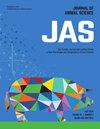Multiple association studies identify three novel candidate genes for teat number trait in Danish Landrace and Large White pigs: BRINP3, LIN52, and UBE3B
IF 2.7
2区 农林科学
Q1 AGRICULTURE, DAIRY & ANIMAL SCIENCE
引用次数: 0
Abstract
Milk is an essential source of nutrition for pre-weaning piglets. Therefore, in the breeding process, sows were expected to have sufficient teats to suckle their piglets. However, in Danish Landrace and Large White pigs, the number of piglets born currently exceeds the number of teats, making it urgent to select and breed for an increased teat number. In this study, the samples of 491 Danish Landrace pigs and 1047 Danish Large White pigs with teat number phenotype were used to perform genome-wide association studies (GWAS) to identify SNPs associated with total teat number (TTN) based on SNP-chip data and data imputed to the level of whole-genome sequencing (iWGS), respectively. In Landrace pigs, the most significant SNP on SSC10 explains 5.14% of the phenotypic variance, while in Large White pigs, the most significant SNP on SSC7 explains 4.46% of the phenotypic variance. Additionally, linkage disequilibrium and linkage analysis (LDLA) were used to refine the regions of QTLs on SSC10 to 2.89 Mb ~ 5.43 Mb in Danish Landrace pigs and to 96.00Mb ~ 97.95 Mb on SSC7 in Danish Large White pigs, respectively. To maximize the utility of information from two populations, meta-analysis was conducted across multiple populations. A total of 12 protein-coding genes were identified within the candidate QTL regions determined by LDLA and meta-analysis. To supplement the candidate gene set, transcriptome-wide association studies (TWAS) based on embryo and placenta tissues identified 7 protein-coding genes associated with TTN in Landrace and Large White pigs. Phenome-wide association studies (PheWAS) query was conducted for all the above genes, revealing that nearly all of them are associated with teat number traits. Additionally, some genes showed strong associations with carcass traits, suggesting a potential association between teat number and carcass traits. Through functional annotation and integrated analysis, BRINP3, LIN52, ABCD4, and UBE3B were determined as the functional candidate genes regulating TTN. These findings lay the foundation for identifying the genetic loci regulating teat number in Danish pigs, as well as for their molecular breeding.多项关联研究确定了丹麦长白猪和大白猪乳头数性状的三个新的候选基因:BRINP3、LIN52和UBE3B
乳是断奶前仔猪必不可少的营养来源。因此,在繁殖过程中,母猪应该有足够的奶水来哺乳仔猪。然而,在丹麦长白猪和大白猪中,目前仔猪的出生数量超过了奶头数量,因此迫切需要选择和繁殖增加奶头数量。本研究利用491头丹麦长白猪和1047头丹麦大白猪的乳头数表型样本进行全基因组关联研究(GWAS),分别基于snp芯片数据和全基因组测序(iWGS)水平的数据,鉴定与总乳头数(TTN)相关的snp。在长白猪中,SSC10上最显著的SNP解释了5.14%的表型变异,而在大白猪中,SSC7上最显著的SNP解释了4.46%的表型变异。此外,利用连锁不平衡和连锁分析(LDLA)将丹麦长白猪SSC10上的qtl区域分别细化为2.89 Mb ~ 5.43 Mb,丹麦大白猪SSC7上的qtl区域细化为96.00Mb ~ 97.95 Mb。为了最大限度地利用来自两个种群的信息,对多个种群进行了荟萃分析。在LDLA和meta分析确定的候选QTL区域内共鉴定出12个蛋白质编码基因。为了补充候选基因集,基于胚胎和胎盘组织的转录组全关联研究(TWAS)在长白猪和大白猪中鉴定了7个与TTN相关的蛋白质编码基因。对上述所有基因进行全现象关联研究(PheWAS)查询,发现几乎所有基因都与数量性状相关。此外,一些基因与胴体性状有较强的相关性,表明乳数与胴体性状之间存在潜在的相关性。通过功能注释和综合分析,确定BRINP3、LIN52、ABCD4和UBE3B是TTN的功能候选基因。这些发现为确定丹麦猪体内调节乳头数量的基因位点及其分子育种奠定了基础。
本文章由计算机程序翻译,如有差异,请以英文原文为准。
求助全文
约1分钟内获得全文
求助全文
来源期刊

Journal of animal science
农林科学-奶制品与动物科学
CiteScore
4.80
自引率
12.10%
发文量
1589
审稿时长
3 months
期刊介绍:
The Journal of Animal Science (JAS) is the premier journal for animal science and serves as the leading source of new knowledge and perspective in this area. JAS publishes more than 500 fully reviewed research articles, invited reviews, technical notes, and letters to the editor each year.
Articles published in JAS encompass a broad range of research topics in animal production and fundamental aspects of genetics, nutrition, physiology, and preparation and utilization of animal products. Articles typically report research with beef cattle, companion animals, goats, horses, pigs, and sheep; however, studies involving other farm animals, aquatic and wildlife species, and laboratory animal species that address fundamental questions related to livestock and companion animal biology will be considered for publication.
 求助内容:
求助内容: 应助结果提醒方式:
应助结果提醒方式:


